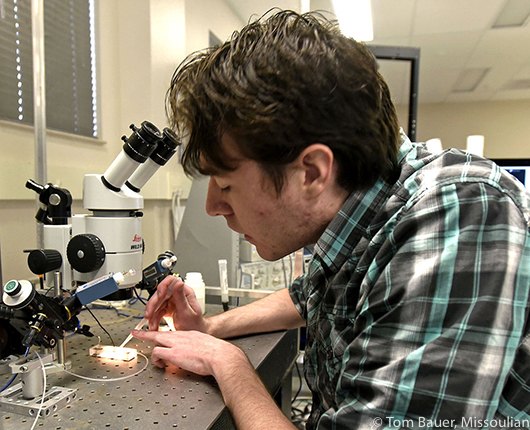Neuroscience and the Rise of Futuristic Technology

By Andrew T. Kinney, UM Neuroscience Major
What is neuroscience? Simply put, it is the scientific discipline that seeks to discover the inner workings of the brain. To the casual observer this might seem like a narrow topic, but neuroscience is a broad field of study informed by many different sciences.
Neuroscience is a catch-all term for three major fields of brain research. The first of these fields is behavioral neuroscience. It may look in some ways like psychology, but it delves deeper into the biology of brains, studying the circuits that give rise to behaviors. Another important field is cellular and molecular neuroscience, which investigates how the brain works on a cellular level. Most research in cellular and molecular neuroscience addresses how nerve cells, or neurons, communicate with one another, examining their life cycles and the movements of signaling molecules within them. The third field is the youngest, most nuanced, and potentially most exciting of the three: computational neuroscience.
Computational neuroscience is the study of how brains process information and seeks to build mathematical models of brain interactions. Models are key parts of every science for two reasons. The first is that models allow researchers to study complex systems without taking them apart, which is useful when your object of study is the human brain. The second is that models are simpler than the systems they are based upon, making them easier to study. This simplicity may seem like a drawback, but by studying a simple system, researchers can find truths that are not apparent in complex ones.
Mathematical models of the brain have many useful applications in neuroscience. They can help researchers understand the way brains encode, store, retrieve, and export information. Another feature of these models is that they can be used by computers to create detailed maps of brain structure and function. Using these maps, scientists have developed combinations of software and hardware that can communicate with brains, known as brain-computer interfaces, or BCIs. BCIs receive information from neurons and translate it into electrical signals, which are then used to control a device. BCIs have a wide range of applications in clinical medicine, especially for the physically disabled. They can allow amputees to control robotic limbs. They can even be used for hands-free typing, which might eventually enable people with full body paralysis to communicate. Clearly BCIs are useful, practical tools that have the potential to help many people, but computational neuroscience also has many interesting theoretical applications.
Think for a moment of artificial intelligence, also known as AI. AI is one of the pivotal recurring themes of science fiction, indeed of all speculative fiction. Ever since the classical story “The Golem of Prague,” we humans have fantasized about creating AIs. Most often, AIs in fiction are created as servants; they are walking, talking, intelligent machines designed to carry out tasks that are too dangerous or computationally demanding for humans. These servant AIs are more commonly termed “robots,” the Czech word for slave. Robots permeate our popular culture now more than ever and are a staple of modern entertainment. Robots take a variety of forms; some are information powerhouses like C3PO of Star Wars fame, others are rampaging war machines like the T-800 Terminator, still others are cute, child friendly machines like Adventure Time’s B-MO. Optimistic writers like Isaac Asimov dreamed of robots that would safeguard humankind, whereas bleaker futurists envisioned a world in which robots would enslave or destroy us.
Computational neuroscience provides fertile ground in which to plant the seeds of artificial intelligence. By generating computerized models of brains, we further our understanding of what is needed to build one. As this understanding develops, we may find ways to create minds in machines, or even do so accidentally. In other words, by building a sufficiently advanced simulation of a brain, we might accidentally create a mind within it.
Perhaps the most exciting feature of computational neuroscience is its relative youth - the term has only been in use since the mid-eighties. With such a young field, there are a vast number of discoveries yet to be made. Scientists from other fields would probably like to point out that there are new discoveries to be made in every area of study, and this is true, but computational neuroscience has an incredibly diverse array of applications. After all, few other disciplines are pushing back the boundaries of both clinical medicine and artificial intelligence.
